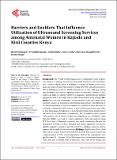| dc.contributor.author | Matiang’i, Micah | |
| dc.contributor.author | Joosse, Koen | |
| dc.contributor.author | Ngunju, Priscillah | |
| dc.contributor.author | Kiilu, Colleta | |
| dc.contributor.author | Harkx, Romy | |
| dc.contributor.author | Hangelbroek, Marianne | |
| dc.contributor.author | Omogi, Jarim | |
| dc.date.accessioned | 2021-09-10T21:35:14Z | |
| dc.date.available | 2021-09-10T21:35:14Z | |
| dc.date.issued | 2/5/2021 | |
| dc.identifier.citation | : Matiang’i, M., Ngunju, P., Kiilu, C., Harkx, R., Hangelbroek, M. and Omogi, J. (2021) Barriers and Enablers That Influence Utilization of Ultrasound Screening Services among Antenatal Women in Kajiado and Kisii Counties Kenya. Open Journal of Clinical Diagnostics, 11, 1-17. https://doi.org/10.4236/ojcd.2021.111001 | en_US |
| dc.identifier.issn | 2162-5824 | |
| dc.identifier.other | ISSN Print: 2162-5816 | |
| dc.identifier.other | https://www.scirp.org/journal/ojcd | |
| dc.identifier.uri | http://repository.amref.org/handle/123456789/242 | |
| dc.description | Copyright © 2021 by author(s) and
Scientific Research Publishing Inc.
This work is licensed under the Creative
Commons Attribution International
License (CC BY 4.0).
http://creativecommons.org/licenses/by/4.0/ | en_US |
| dc.description.abstract | Background: The World Health Organization recommends to have all pregnant women to undergo an obstetric ultrasound scan before 24 weeks gestation. However, this has been a challenge as a result of limited access to appropriate Point of Care Ultrasound Screening (POCUS) services in lower levels of developing countries’ Health Systems, cost of care, skills gap among care providers and unclear regulatory policy frameworks. Obstetric Ultrasound scan helps to confirm viability of a pregnancy, gestational age, multiple pregnancies and it also helps rule out fetal abnormalities early enough. Methods: One year after intervention, a cross-sectional study was carried in the two pilot counties of Kisii (rural) and Kajiado (peri-urban). This followed after selected midwives in the two counties were trained on basic obstetric ultrasound screening for ANC women. A total of 366 women who were either in their last phases of pregnancy or had delivered within three months before the survey were interviewed. Cumulatively, the 36 midwives had screened 1,250 mothers out of whom 18 high risk pregnancies were identified. Open Data Kit (ODK) was used to collect quantitative data and analysed using STATA version 15. Descriptive statistics were used to summarize the data test associations between variables. Bivariate and logistic regression was used to identify predictive variables, and ORs with 95% confidence intervals used to measure the strength of the associations. Findings: Slightly more than a third (36%) of the women had recently delivered. In total, Kisii (rural county) had a representation of 59% of the respondents. Half of the respondents were aged between 25 - 34 years, 55% of the women interviewed were housewives while 48% had secondary level of education. Only 21% of the women had undergone routine ultrasound screening before 24 weeks of gestation with the average distance travelled by majority (45%) of the respondents to access the POCUS service being 3 - 5 km. The need to confirm a pregnancy’s gestation was the major (68.1%) motivator for seeking the service in the two pilot counties. Employment status, household income, education level, pregnancy gestation and distance to the facility had a statistical significance (P < 0.05) with ultrasound utilization. Highest education level, pregnancy gestation and distance to the nearest ultrasound screening facility were found to significantly predict the likelihood of utilizing the ultrasound services (P < 0.05). The initial training and continuous hands-on coaching of midwives by TOTs contributed a lot to acquisition of the desired basic obstetric ultrasound screening skills. Conclusion: Women in developing countries are eager to access obstetric ultrasound screening services but for limited opportunities and sustainable implementation frameworks on Point of Care Ultrasound Screening (POCUS) services. Training and continuous coaching of frontline health professionals are critical in deployment of POCUS but there is limited access to standardised training content. | en_US |
| dc.description.sponsorship | Philips Foundation supported by expertise from Philips | en_US |
| dc.language.iso | en | en_US |
| dc.publisher | Scientific Research Publishing | en_US |
| dc.subject | Point of Care Ultrasonography Screening (POCUS) | en_US |
| dc.subject | Midwives | en_US |
| dc.subject | Antenatal | en_US |
| dc.subject | Primary Health Care Settings | en_US |
| dc.subject | Business Model | en_US |
| dc.title | Barriers and Enablers That Influence Utilization of Ultrasound Screening Services among Antenatal Women in Kajiado and Kisii Counties Kenya | en_US |
| dc.type | Article, Journal | en_US |

